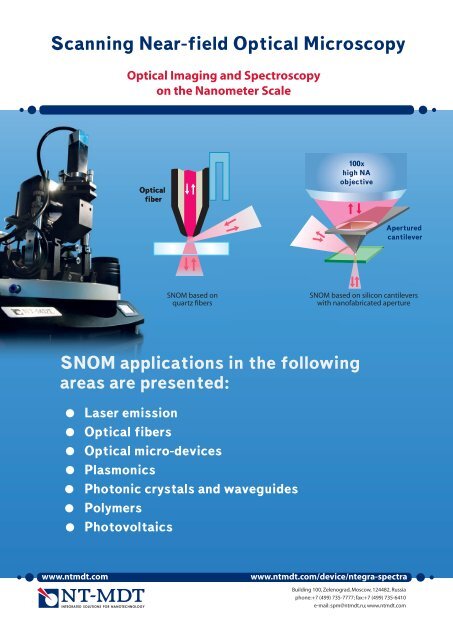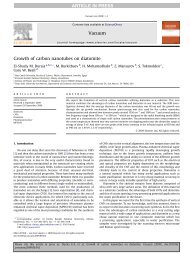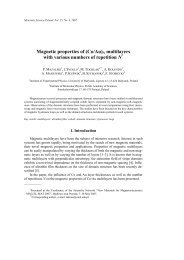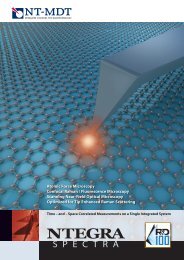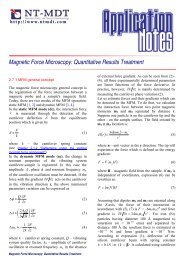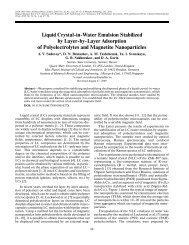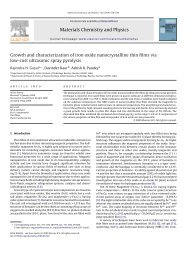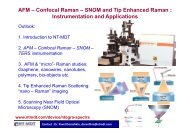SNOM digest
SNOM digest
SNOM digest
You also want an ePaper? Increase the reach of your titles
YUMPU automatically turns print PDFs into web optimized ePapers that Google loves.
Scanning Near-field Optical Microscopy<br />
Optical Imaging and Spectroscopy<br />
on the Nanometer Scale<br />
Optical<br />
fiber<br />
100x<br />
high NA<br />
objective<br />
Apertured<br />
cantilever<br />
<strong>SNOM</strong> based on<br />
quartz fibers<br />
<strong>SNOM</strong> based on silicon cantilevers<br />
with nanofabricated aperture<br />
<strong>SNOM</strong> applications in the following<br />
areas are presented:<br />
Laser emission<br />
Optical fibers<br />
Optical micro-devices<br />
Plasmonics<br />
Photonic crystals and waveguides<br />
Polymers<br />
Photovoltaics<br />
www.ntmdt.com<br />
www.ntmdt.com/device/ntegra-spectra<br />
Building 100, Zelenograd, Moscow, 124482, Russia<br />
phone: +7 (499) 735-7777; fax: +7 (499) 735-6410<br />
e-mail: spm@ntmdt.ru; www.ntmdt.com
Scanning Near-field Optical Microscopy (<strong>SNOM</strong>)<br />
Optical Imaging and Spectroscopy on the Nanometer Scale<br />
Scanning near-field optical microscopy (<strong>SNOM</strong>) enables studying a sample’ s optical properties with resolution far beyond<br />
the diffraction limit. Sample fluorescence, light emission, transmission, scattering etc. can be mapped with the spatial<br />
resolution down to tens of nanometers.<br />
Two main approaches to the near-field microscopy exist: (i) aperture type <strong>SNOM</strong> and (ii) apertureless techniques.<br />
In the first case, a subwavelength size aperture on a scanning tip is used as an optical probe. This is usually an opening in<br />
a metal coating of either an optical fiber tip or of a cantilever. Spatial resolution in the aperture type <strong>SNOM</strong> is, in general,<br />
determined by the aperture diameter.<br />
Apertureless techniques are based on the near-field optical phenomena as well, but do not require passing the light<br />
through an aperture. Apertureless/Scattering <strong>SNOM</strong>, Tip Enhanced Raman/Fluorescence, STM Light Emission and others<br />
can be mentioned in this regard.<br />
<strong>SNOM</strong> techniques are widely used in nanophotonics (plasmonics, photonic crystals & waveguides etc.), laser technology,<br />
optical micro-devices, material science.<br />
NT-MDT <strong>SNOM</strong> Features:<br />
All major types of <strong>SNOM</strong> probes and measuring modes supported<br />
Apertured cantilevers, different types and shapes of apertured optical fibers and even sharpened metal wires can be used<br />
as <strong>SNOM</strong> probes. Major <strong>SNOM</strong> measuring modes are: Transmission, Collection and Reflection. Signals measured: laser<br />
intensity, fluorescence intensity and full emission spectra.<br />
Apertureless techniques: Scattering <strong>SNOM</strong>, Tip Enhanced Raman/Fluorescence and others<br />
In general, all types of optical, mechanical, and electrical interactions between the probe, sample and incident light source<br />
can be studied by NT-MDT <strong>SNOM</strong> setup.<br />
Scanning by sample and/or by probe<br />
Depending on the type of sample and measurement, it is important to have the option to scan either by the sample<br />
or by the probe to obtain <strong>SNOM</strong> images.<br />
Environmental control (temperature, gases, humidity, liquid and external magnetic field)<br />
Temperature control and air flow isolation are the key issues for measurements stability. Sample heating and controlled gas<br />
atmosphere removes the residual water layer on the sample (this is usually present in ambient conditions and affects any<br />
surface measurements). This prevents unwanted chemical reactions on the surface and other measurement artifacts.<br />
Extended spectral region (UV – Vis – IR)<br />
Standard supported wavelength range is 400 – 1700 nm. Customized solutions for wider ranges are possible.<br />
Easy integration with AFM & confocal Raman microscopy<br />
Universal NT-MDT NTEGRA SPM base allows one to switch easily between any types of AFM/STM/<strong>SNOM</strong> measuring<br />
heads and environmental cells. The setup can be further integrated with a Raman spectrometer to provide simultaneous<br />
AFM/Confocal Raman & fluorescence imaging in addition to <strong>SNOM</strong>.<br />
www.ntmdt.com<br />
www.ntmdt-tips.com
Scanning Near-field Optical Microscopy (<strong>SNOM</strong>)<br />
Optical Imaging and Spectroscopy on the Nanometer Scale<br />
<strong>SNOM</strong> Imaging for Laser Studies<br />
Study of Laser Emission Properties<br />
<strong>SNOM</strong> can be effectively used to study laser emission properties. Both near-field (right at the laser facet) and far-field<br />
(at a certain distance from the facet) emission patterns can be obtained with high spatial resolution (
Scanning Near-field Optical Microscopy (<strong>SNOM</strong>)<br />
Optical Imaging and Spectroscopy on the Nanometer Scale<br />
<strong>SNOM</strong> for Optical Micro-devices<br />
Near-field Focusing of a Phase Micro-Fresnel Zone Plate<br />
Focusing behavior of a binary phase micro-Fresnel zone plate (FZP) fabricated using focused ion beam milling<br />
on a glass substrate is studied by <strong>SNOM</strong>. It is found that an asymmetric spot with subwavelength beam width<br />
and elongated depth of focus can be obtained from the phase micro-FZP. The measurements are consistent with<br />
calculation results.<br />
a.<br />
b. c.<br />
f. g.<br />
d. e.<br />
Fig. 5. (a) Experimental setup. (b) SEM image and (c) shear-force topography of the phase micro-FZP. The phase plate has eight full zones<br />
with the etch depth about 300 nm. (d), (e) Calculated electric field intensity distribution of the incident and transmitted lights in XZ and XY<br />
plane. (f), (g) Experimental intensity distribution of the electric field intensity (detected by <strong>SNOM</strong>) after being transmitted through the phase<br />
micro-FZP at planes located at 10 nm and 750 nm height from the plate surface.<br />
Data from: R.G. Mote, S.F. Yu, A. Kumar, W. Zhou, X.F. Li, APPLIED PHYSICS B 102: 95–100 (2011).<br />
Characterization of a Micro-focusing Plasmonic Device<br />
Focusing behavior of Au based focusing plasmonic device is characterized by <strong>SNOM</strong>. The experimental results show<br />
a significant focusing effect in agreement with the simulation results.<br />
a. b.<br />
Fig. 6. (a) SEM image of the device. (b) The electric field intensity distribution<br />
of the transmitted lights through the plasmonic device (simulated).<br />
The transmitted fields are detected with the <strong>SNOM</strong>. The intensity distribution<br />
of the transmitted lights at the horizontal planes with the distances<br />
of (c) z=0.5 µm, (d) z=1.6 µm, (e) z=2.5 µm, and (f) z=3.5 µm away from<br />
the device surface. (g) The intensity distribution along the solid line in (d).<br />
Data from: Dr. Fenghuan Hao, Dr. Rui Wang and Dr. Jia Wang ,<br />
OPTICS EXPRESS Vol. 18, No. 3, 15741- 15746 (2010).<br />
4<br />
3<br />
2<br />
1<br />
0<br />
-1<br />
-2<br />
-3<br />
-4<br />
c.<br />
4<br />
3<br />
2<br />
1<br />
0<br />
-1<br />
-2<br />
d.<br />
z=0.5 µm -3 z=1.6 µm -3 z=2.5 µm -3 z=3.5 µm<br />
4<br />
3<br />
2<br />
1<br />
0<br />
-1<br />
-2<br />
-4<br />
-4<br />
-4<br />
e.<br />
4<br />
3<br />
2<br />
1<br />
0<br />
-1<br />
-2<br />
f.<br />
g.<br />
www.ntmdt.com<br />
www.ntmdt-tips.com
Scanning Near-field Optical Microscopy (<strong>SNOM</strong>)<br />
Optical Imaging and Spectroscopy on the Nanometer Scale<br />
Light Spot Narrowing by an Assymetric Axicon<br />
Diffraction of a Gaussian beam by axicons is studied by <strong>SNOM</strong>. Binary diffraction axicons with the period close<br />
to the light wavelength are formed by electron beam lithography on a quartz substrate. Different axicon geometries<br />
are studied. It is shown experimentally that asymmetric microaxicon can reduce the spot size of central light beam<br />
along polarization direction in a near zone of diffraction – overcoming the diffraction limit.<br />
a. b. c.<br />
1 µm 1 µm 1 µm<br />
d.<br />
z, nm<br />
500 700 900 1100 1300 1500<br />
Spiral<br />
axicon<br />
1 µm 1 µm 1 µm 1 µm 1 µm 1 µm<br />
Fig. 7.(a) SEM image of the central part of a spiral axicon. (b) The diffracted light intensity distribution detected by <strong>SNOM</strong> in close<br />
proximity to the surface. (c) <strong>SNOM</strong> intensity distribution taken at ~500 nm from the surface. The central part of the beam at this plane<br />
is compressed in a light polarization direction (vertical) and has size less than optical limit. (d) Series of intensity distribution: the height<br />
of a scanning plane was varied from 500 nm to 1500 nm.<br />
Data from: S. N. Khonina, D. V. Nesterenko, A. A. Morozov, R. V. Skidanov, and V. A. Soifer,<br />
OPTICAL MEMORY AND NEURAL NETWORKS, Vol. 21, No. 1, 17-26 (2012).<br />
Focusing of a Radially Polarized Beam by a Solid Immersion Lens<br />
Radially polarized beam focused by a solid immersion lens (SIL) is studied by <strong>SNOM</strong>. It delivers a laser spot beyond<br />
the diffraction limit demonstrating better focusing properties than a common linearly polarized beam.<br />
a. b. c.<br />
Fig. 8. Measured focus spot by a solid immersion lens with incident annular radially polarized beam, i.e., evanescent Bessel beam:<br />
(a) intensity distribution on the SIL bottom surface; (b) intensity along the X direction. The FWHM is 230 nm; (c) intensity along<br />
the Y direction. The FWHM is 180 nm. Size of the spot in both X and Y direction are considerably less than diffraction limit. Laser<br />
wavelength 633 nm.<br />
Data from: Qing Li, Jia Wang, Jiying Xu, Jiefeng Xi and Guofan Jin, OPTICAL REVIEW Vol. 13, No. 4 283–287 (2006).<br />
www.ntmdt.com<br />
www.ntmdt-tips.com
Scanning Near-field Optical Microscopy (<strong>SNOM</strong>)<br />
Optical Imaging and Spectroscopy on the Nanometer Scale<br />
Color Separation in the Fresnel Diffraction Region of Rectangular Grating<br />
Color separation of the incident light in the Fresnel diffraction region is a novel function of high-density dielectric<br />
rectangular gratings. Light of different wavelengths has different diffraction periods in the Z direction. For example,<br />
at 4.2 µm distance from the surface, position of intensity maximum for red excitation laser corresponds to position<br />
of intensity minimum for blue excitation laser — a spatial light separation occurs.<br />
a. b.<br />
c.<br />
λ=633 nm<br />
λ=488 nm<br />
Fig. 9. (a) Schematics of the fabricated grating.<br />
The period of the grating is 1.5 λ (λ = 633 nm), and the<br />
duty cycle is 0.5. (b), (c) Calculated diffraction distributions<br />
for different incident wavelengths:<br />
488 nm and 633 nm correspondingly. (d) The shear-force<br />
topography of the grating. Experimental results scanned<br />
by <strong>SNOM</strong> at z = 4.2 µm: (e) the field distribution with<br />
the incident laser wavelength 633 nm (bottom half) and<br />
488 nm (top half), and (f) the intensity distribution<br />
at the same cross section for different wavelength<br />
of the incident laser.<br />
Data from: Yue Fang, Qiaofeng Tan, Mingqian Zhang and<br />
Guofan Jin, APPLIED OPTICS, Vol. 51, No. 12, 2172-2177 (2012).<br />
d. e. f.<br />
λ=488 nm<br />
λ=633 nm<br />
<strong>SNOM</strong> for Plasmonics<br />
<strong>SNOM</strong> is traditionally used to examine the Surface Plasmon Polaritons (SPP) behavior with high spatial resolution<br />
in all three dimensions (XYZ).<br />
Plasmonic Fan-Out<br />
SPP behavior is often studied in relation to conventional optical devices such as beam splitters and waveguides.<br />
The work conducted by Wang et al. (Fig. 10) realizes traditional fan-out optical arrangement in a plasmonic device.<br />
An optical fan-out element typically splits a single wave into plane waves by using gratings and lenses to generate<br />
an array of light spots.<br />
A plasmonic fan-out array is generated by the structure shown in Fig. 10 (a, b). The device is produced using arrays<br />
of slits on a metal film, the slits being of less than the wavelength dimensions of the initial light. The structure consists<br />
of a 100 nm silver film deposited on a quartz substrate. The slit arrays are cut into the silver film by electron beam<br />
lithography (EBL) at a width of 265 nm to generate the highest surface plasmon response.<br />
The near field characteristics of the SPP pattern are investigated by <strong>SNOM</strong> with an aluminium coated fiber tip.<br />
The results of the imaging analysis are shown in Fig. 10 (c).<br />
www.ntmdt.com<br />
www.ntmdt-tips.com
Scanning Near-field Optical Microscopy (<strong>SNOM</strong>)<br />
Optical Imaging and Spectroscopy on the Nanometer Scale<br />
a.<br />
b. c.<br />
E<br />
2D fan-out dot array<br />
plasmonics fan-out element<br />
2µm<br />
2µm<br />
Fig. 10. (a) Subwavelength slit arrays are used to generate SPP waves propagating along the metal surface and four perpendicular<br />
counter-propagating SPP waves interfered each other to form the localized plasmonic dots array. (b) SEM image of subwavelength slit<br />
arrays structure. (c) 2D Near field image of electrical field distribution for diagonal polarization direction. Inset is the SPP field intensity<br />
distribution of the structure’s centre area. The white arrow indicates the incident polarization direction. Excitation laser wavelength<br />
is 633 nm.<br />
Data from: Wang Qian, Jing Bu, X.-C. Yuan, OPTICS EXPRESS, Vol. 18, No. 3, 2662-2667 (2010).<br />
Generation of Plasmonic Moiré Fringes Using Phase-engineered Optical Vortex Beam<br />
The work demonstrates the dynamic generation of two dimensional (2D) plasmonic Moiré fringes resulting from<br />
the overlapping of two Surface Plasmon Polaritons (SPP) standing waves with an angular misalignment. The SPP waves<br />
are excited by an optical vortex (OV) beam with different topological charges (l= ±6). The sign of l determines handedness<br />
of the helical wave front. Due to their unique phase properties, OV beams provide a natural and simple phase<br />
modulation method to effectively and dynamically manipulate SPPs.<br />
a.<br />
b.<br />
Fig. 11. (a) SEM image of four metallic gratings to generate<br />
plasmonic Moiré fringes. Black arrow shows the polarization direction<br />
of incident optical vortex beam. Red and blue arrows show<br />
the propagation direction of SPP excited by positive and negative<br />
topological charge optical vortex beams, respectively. (b) <strong>SNOM</strong><br />
measured Moiré fringes resulting from overlapping of the two SPP<br />
standing waves.<br />
Data from: Guanghui Yuan, Qian Wang, and Xiaocong Yuan,<br />
OPTICS LETTERS, Vol. 37, No. 13, 2715-2717 (2012).<br />
Guided Plasmons on a Gold Waveguide<br />
Surface plasmon polariton (SPP) propagation in an SPP waveguide is studied using <strong>SNOM</strong> equipped with a heterodyne<br />
interferometer. Both intensity and phase distribution of SPP electromagnetic field are measured.<br />
Topography Amplitude Phase<br />
a. b. c.<br />
Fig. 12. (a) Topography of the waveguide.<br />
(b) Amplitude of the electromagnetic field coupled<br />
by <strong>SNOM</strong> probe. (c) Phase of the electromagnetic field.<br />
785 nm excitation laser is used.<br />
Data from: Antonello Nesci and Olivier J.F. Martin.<br />
www.ntmdt.com<br />
www.ntmdt-tips.com
Scanning Near-field Optical Microscopy (<strong>SNOM</strong>)<br />
Optical Imaging and Spectroscopy on the Nanometer Scale<br />
SERS Substrate<br />
a. b.<br />
Fig. 13. SERS substrate – Au nanodiamond array on quartz.<br />
(a) AFM topography and (b) <strong>SNOM</strong> image, transmission mode.<br />
Period of the structure: 200 nm.<br />
Resolution of <strong>SNOM</strong> image: ~50 nm.<br />
Data from: I. Arkov, E. Kuznetsov, NT-MDT.<br />
Sample courtesy: Henrik Schneidewind, Institute of Photonic Technology<br />
(IPHT Jena), Germany.<br />
Polarization-Controlled Tunable Directional Coupling of Surface Plasmon Polaritons<br />
The polarization states of the optical signal that can be<br />
coupled to a plasmonic device are often limited by the<br />
selectivity of the coupling process. For directional SPP<br />
excitation, usually only the component of the incident<br />
light that is polarized perpendicularly to either groove- or<br />
ridge-like scattering elements (in the case of gratings)<br />
or to the metal surface itself (in the case of prism-based<br />
schemes) can be coupled into SPPs . Light in the orthogonal<br />
polarization does not couple to SPPs, leading to a decrease<br />
in the SPP signal and a loss of information about the<br />
incident polarization state.<br />
Additional challenges arise in controlling the direction<br />
of propagation of the generated SPPs. Usually the<br />
direction of propagation of generated SPPs is difficult<br />
to control, that results in a substantial source of noise<br />
and reduces efficiency. This work presents a directional<br />
plasmonic coupler that addresses these challenges by<br />
offering polarization-invariant coupling efficiency to SPPs<br />
a. b.<br />
c.<br />
d.<br />
while allowing full control over the distribution of power<br />
Fig. 14. Surface plasmon polaritons (SPP) formed by coupler<br />
between two counter-propagating SPP modes. This<br />
structure: (a) SEM image of a structure fabricated in a gold film<br />
includes unidirectional coupling and preserves polarization<br />
for operation at λ=633 nm. <strong>SNOM</strong> images of the structure<br />
information.<br />
backilluminated by light with different polarizations<br />
A special structure was fabricated in a 150-nm-thick gold (b) linear, (c) right circular, (d) left circular.<br />
film using focused ion beam milling (FIB). The structure<br />
was backilluminated with polarized 633-nm laser light, and<br />
the SPPs were measured using scanning near-field optical<br />
Data from: Jiao Lin, J. P. Balthasar Mueller, Qian Wang, Guanghui<br />
Yuan, Nicholas Antoniou, Xiao-Cong Yuan, Federico Capasso,<br />
SCIENCE, Vol. 340 , 331-334 (2013)<br />
microscopy.<br />
<strong>SNOM</strong> for Photonic Crystals<br />
Light Propagation in a Photonic Crystal Waveguide<br />
Aperture-<strong>SNOM</strong> in collection mode is used to correlate the electromagnetic field distribution with the surface<br />
topography of the photonic crystal.<br />
The optical near-field confined above the sample surface is collected by a <strong>SNOM</strong> tip, placed several nanometers above<br />
the sample surface.<br />
www.ntmdt.com<br />
www.ntmdt-tips.com
Scanning Near-field Optical Microscopy (<strong>SNOM</strong>)<br />
Optical Imaging and Spectroscopy on the Nanometer Scale<br />
a.<br />
b.<br />
Fig. 15. Light propagation in a one-line-defect photonic crystal (PhC) waveguide patterned<br />
into a 450 nm thick free-standing lithium niobate membrane. <strong>SNOM</strong> topography<br />
(a) and optical near-field (b) images recorded above the surface of the PhC waveguide. The Bloch<br />
wave vectors of the PhC waveguide can be retrieved from optical near-field images.<br />
Data from: R. Geiss, S. Diziain, N. Janunts, APPLIED PHYSICS LETTERS 97, 131109 (2010).<br />
10 µm<br />
Analysis of Slow Bloch Modes in a Photonic Crystal<br />
The photonic crystal is prepared by drilling a honeycomb lattice of air holes in the InP slab using e-beam lithography<br />
followed by reactive ion etching. Near-field optical microscopy is used to visualize the evanescent component of the<br />
mode with a spatial resolution below the diffraction limit.<br />
a. b. c.<br />
Fig. 16. (a) Shear-force topographic image (2×2 µm). (b) Optical near-field image at 1611 nm (2×2 µm), circles indicate holes positions<br />
of the 2D-Photonic crystal. Doughnut-shaped monopolar modes in each unit cell are observed, having the inner and outer radiuses<br />
70 nm and 310 nm correspondingly. (c) Simulated electrical field intensity at the surface of the photonic crystal (2×2 µm).<br />
Data from: Thanh-Phong Vo, Adel Rahmani, Ali Belarouci, Christian Seassal, Dusan Nedeljkovic and Ségolène Callard,<br />
OPTICS EXPRESS, Vol. 18, No. 26, 26879-26886 (2010).<br />
<strong>SNOM</strong> for Polymers<br />
Perylene Embedded in Polyfluorene<br />
Perylene (a small-molecular organic semiconductor) was embedded in Polyfluorene (PFO) polymer organic<br />
semiconductor thin film forming a rhombus structure. <strong>SNOM</strong> transmission spectroscopy scheme was used to study<br />
the optical proprieties of the structure. It is known that fluorescence properties of perylene nanosheets directly relate<br />
to their crystal structures. For β-phase rhombus perylene, the fluorescence peak is around 620 nm, which can be<br />
clearly observed from fluorescent spectra along the section on the <strong>SNOM</strong> image. Excitation laser wavelength<br />
was 473 nm.<br />
a. b. c.<br />
5 µm 5 µm<br />
Fig. 17. (a) AFM image of Perylene embedded in PFO. (b) <strong>SNOM</strong> transmission image. (c) Fluorescent spectra for 10 points of section<br />
from the <strong>SNOM</strong> image.<br />
Data from: E. Kuznetsov, S. Timofeev, P. Dorozhkin, NT-MDT.<br />
Sample courtesy: Xinping Zhang, Beijing University of Technology, College of Applied Sciences.<br />
www.ntmdt.com<br />
www.ntmdt-tips.com
Scanning Near-field Optical Microscopy (<strong>SNOM</strong>)<br />
Optical Imaging and Spectroscopy on the Nanometer Scale<br />
<strong>SNOM</strong> for Photovoltaics<br />
Localized <strong>SNOM</strong> Excitation for Solar Cell Studies<br />
<strong>SNOM</strong> is used for localized optical excitation of a monocrystalline silicon solar cell. Topography, local surface<br />
reflection and localized photoresponse of the cell are simultaneously mapped while scanning with the <strong>SNOM</strong> probe.<br />
This allows characterizing near-surface defects and other optoelectrical properties of the cell with high spatial<br />
resolution and correlating them with the surface topography.<br />
a. b.<br />
Photocurrent<br />
I<br />
Fig. 18. (a) Scheme of setup. (b) Overlay of sample topography (3D surface profile) and localized photo-induced current (color scale).<br />
Data from: P. Tománek, P. Škarvada, R. Macků, and L. Grmela, Advances in Optical Technologies, Volume 2010, Article ID 805325 (2010).<br />
NT-MDT <strong>SNOM</strong> Specification<br />
<strong>SNOM</strong> & other probes<br />
<strong>SNOM</strong> optical fibers; <strong>SNOM</strong> apertured cantilevers;<br />
All types of AFM cantilevers; Sharp metal wires<br />
Supported standard modes<br />
<strong>SNOM</strong> modes: Transmission; Collection; Reflection<br />
AFM modes*: >30 modes (MFM, SKM, SCM, SRI,<br />
LFM, EFM, SThM, UFM, PFM, AFAM and others)<br />
Detected optical signals<br />
Laser intensity; Fluorescence intensity;<br />
Spectroscopy (full spectrum at each point)<br />
Excitation/detection wavelength range<br />
400 – 1700 nm; Customized solutions<br />
for wider ranges are possible<br />
Advanced near-field modes and techniques<br />
Scattering <strong>SNOM</strong> (s-<strong>SNOM</strong>); Apertureless <strong>SNOM</strong><br />
(a-<strong>SNOM</strong>); Tip Enhanced Raman Scattering (TERS);<br />
Tip Enhanced Fluorescence Spectroscopy (TEFS);<br />
<strong>SNOM</strong> lithography (vector, raster); Light emission/<br />
absorption at AFM/STM gap; Polarization microscopy<br />
Optical detectors<br />
Photon multipliers (VIS, IR); Spectrometer<br />
with TE cooled CCD camera; Avalanche<br />
photodiodes (photon counting regime)<br />
Scanning and feedback mechanisms<br />
Scan by tip & scan by sample regime (100 x 100 µm)<br />
High resonance XYZ piezotube for fast scanning<br />
(closed-loop feedback); Flat piezo-driven<br />
scanning stage (closed-loop feedback)<br />
Laser based cantilever deflection detection (VIS or IR<br />
laser); Quartz tuning fork resonator force detection<br />
system (shear force & normal force regimes)<br />
Other features<br />
Easy upgrade/integration with confocal<br />
Raman/Fluorescence microscopy<br />
Automated alignment of laser spot to<br />
aperture of <strong>SNOM</strong> cantilever<br />
Very high efficiency (numerical aperture)<br />
excitation/collection optics<br />
Environmental control: temperature,<br />
humidity, gases, liquid, magnetic field<br />
Compatible with commercially available<br />
inverted optical microscopes<br />
*May require different types of probes. When probes<br />
are exchanged, exact area of the sample is kept<br />
within µm precision<br />
www.ntmdt.com<br />
www.ntmdt-tips.com
Interdisciplinary Research at the Nanometer Scale<br />
AFM - Raman - <strong>SNOM</strong> - TERS<br />
NTEGRA Spectra<br />
• Atomic Force Microscopy (>30 modes)<br />
• Confocal Raman/fluorescence microscopy<br />
• Scanning near-field optical microscopy (<strong>SNOM</strong>)<br />
• Tip-Enhanced Raman Scattering (TERS) and other<br />
tip-assisted optical techniques (s-<strong>SNOM</strong>, TEFS, etc.)<br />
100x<br />
high NA<br />
objective<br />
Apertured<br />
cantilever<br />
Award winner<br />
Controlled Environment<br />
Temperature – Humidity – Gases – Liquid – Electrochemical – Magnetic Field<br />
www.ntmdt.com<br />
www.ntmdt-tips.com
NT-MDT Head Office<br />
Building 100, Zelenograd, Moscow 124482, Russia<br />
Phone: +7 (499) 735-7777<br />
Fax: +7 (499) 735-6410<br />
E-mail: spm@ntmdt.ru<br />
NT-MDT Europe BV<br />
High Tech Campus 83, 5656 AG Eindhoven,<br />
The Netherlands<br />
Phone: +31(0) 88 338 99 99<br />
Fax: +31(0) 88 338 99 98<br />
E-mail: info@ntmdt.eu<br />
NT-MDT America Inc.<br />
3200 Scott Blvd<br />
Santa Clara, CA 95054<br />
Phone: +1 408 988 8409<br />
Fax: +1 408 988 8442<br />
E-mail: info@ntmdt-america.com<br />
NT-MDT S&L<br />
NT-MDT House, National Technological Park,<br />
Castletroy, Limerick, Ireland<br />
Phone.: +353 (61) 33-33-22<br />
Fax: +353 (61) 33-33-20<br />
E-mail: info@ntmdt.ie<br />
NT-MDT Shanghai<br />
Room 18D, Cross Region Plaze,<br />
No. 899 Lingling Road,<br />
Shanghai 200030, PRC<br />
上 海 市 徐 汇 区 零 陵 路 899 号 飞 洲 国 际 广 场 18 楼 D 座<br />
Phone.: +86 21 5425 9595<br />
Fax: +86 21 5425 0950<br />
E-mail: info@nt-mdt.cn<br />
Building 100, Zelenograd, Moscow, 124482, Russia<br />
phone: +7 (499) 735-7777; fax: +7 (499) 735-6410<br />
e-mail: spm@ntmdt.ru; www.ntmdt.com


